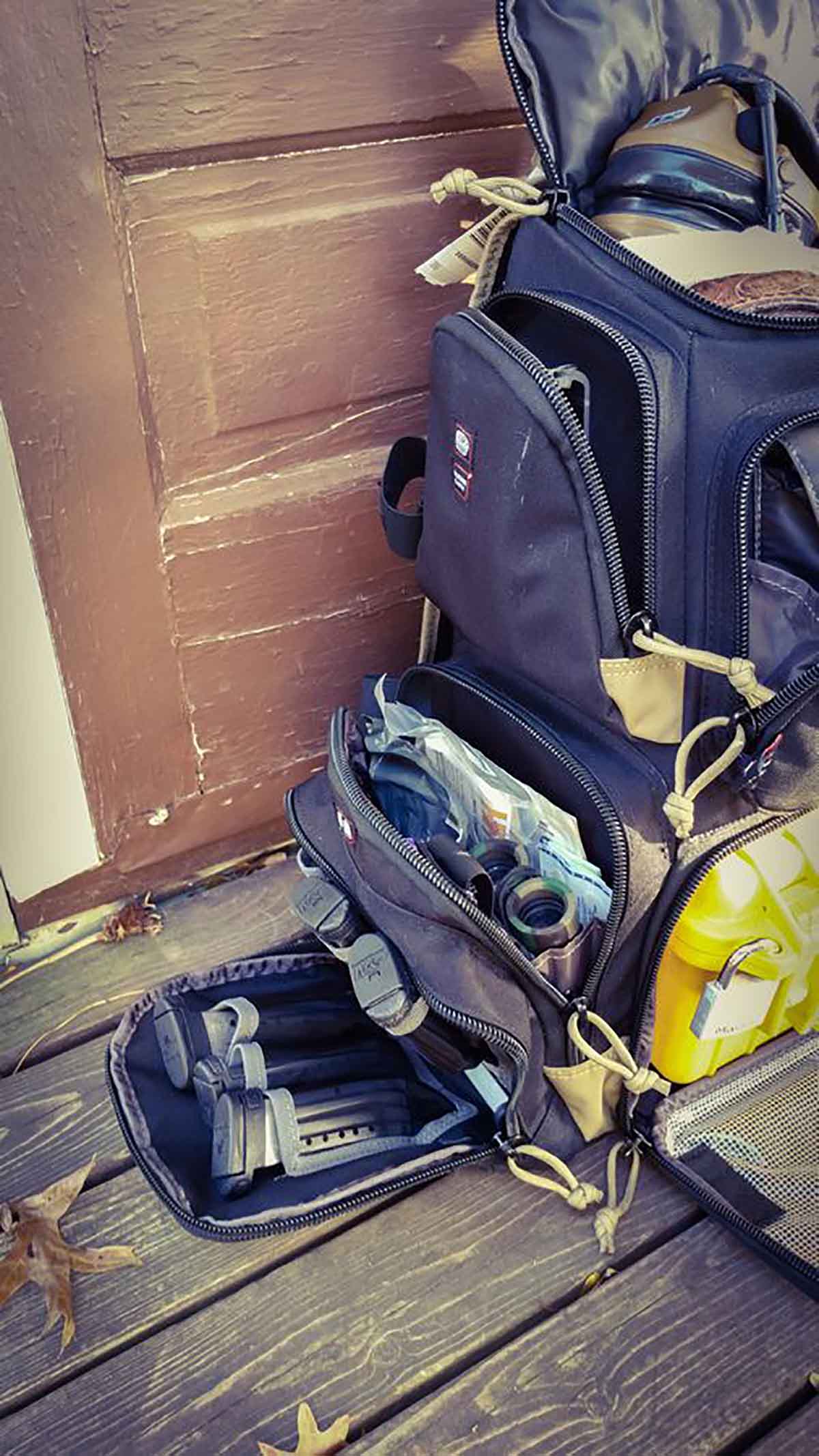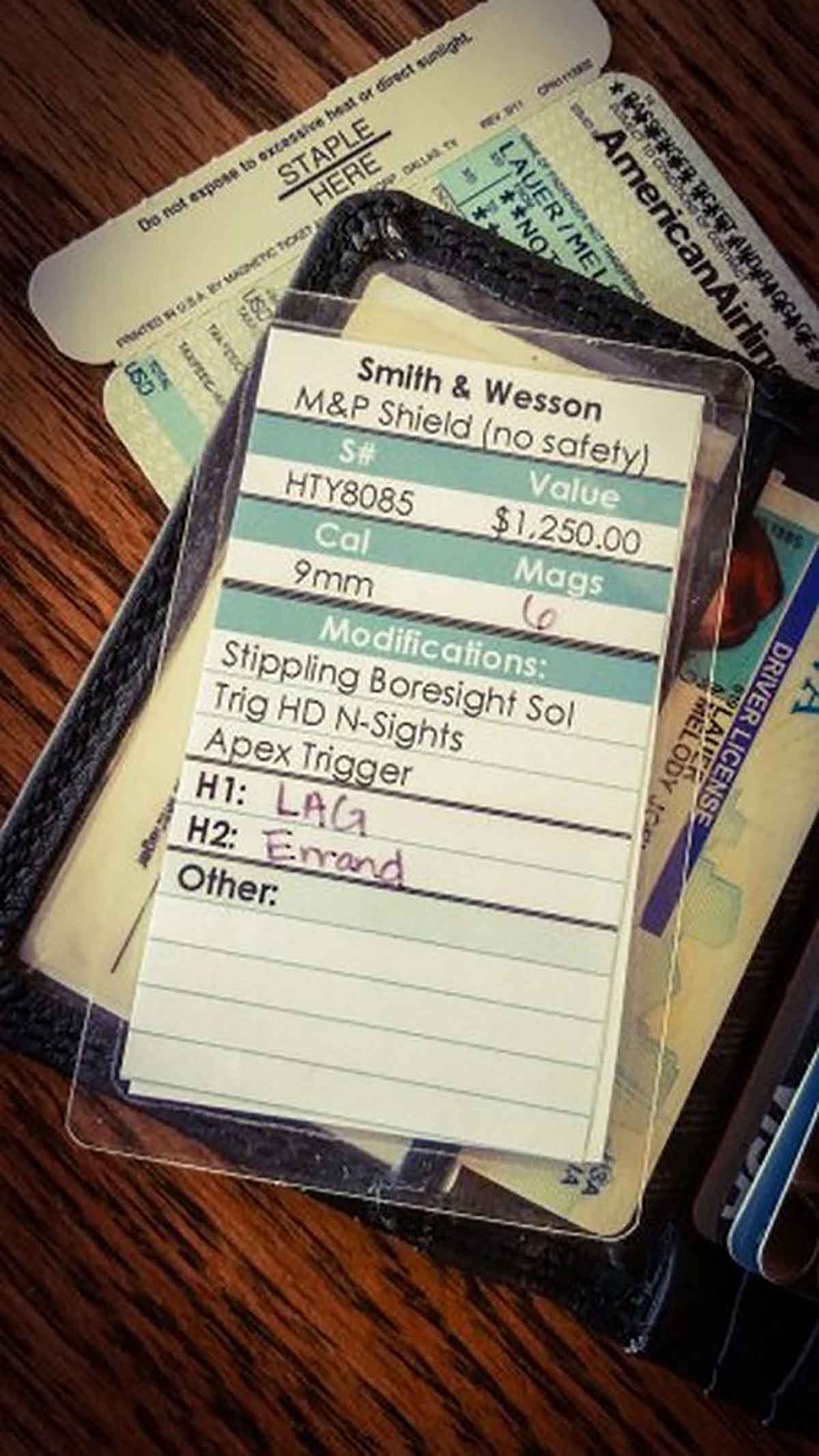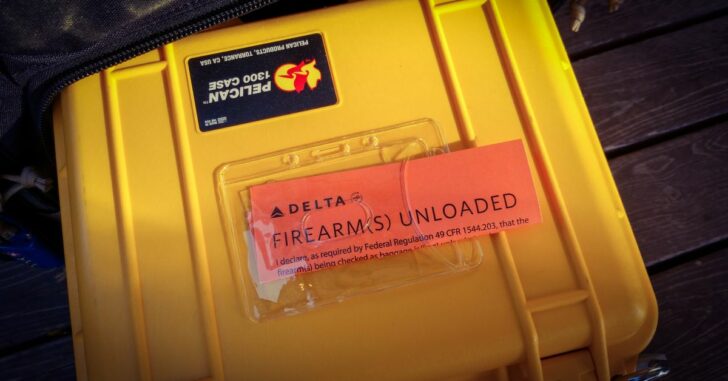By Melody Lauer via melodylauer.com | Republished with permission
I’ve been flying with guns on and off for ten years.
It’s not a complicated process but it’s one of those things that can cause considerable stress for those who haven’t done it before. Not to mention the ever changing guidelines and restrictions can make the process daunting.
In an instant, the Transportation Security Administration (TSA) or a state or an airline can change policy complicating the process.
After years of flying with guns to varying degrees of complexity I decided to streamline the process as much as possible with fantastic results. I’m going to share with you here with the understanding that things could change in a heartbeat and it may no longer be a viable practice five years, months or even days from now. However, as long as things don’t change I’ll continue to fly using these steps and equipment and maybe it will help you smooth out the process as well.
Know Thine Enemy
In order to fly with firearms you have to know what is required. You certainly shouldn’t arrive at the airport a half hour before your flight and find out that you have packaged your guns incorrectly and can’t take them with you.

The TSA requires that firearms be checked in your luggage. They must be unloaded and locked in a hard-sided case.
Ammunition must be boxed and may or may not be included in the box with the guns. Whether or not the magazine itself is considered a box is up for debate but I’ve flown successfully with loaded magazines provided they are in separate locations than the firearm.
For more information on their requirements, go to the TSA’s website detailing flying with firearms and print that page. Keep that information with you as you check in so that if there is any question on how you packed your firearms you can point out your source material immediately.
It’s not always necessary but it can be helpful to search out the individual airlines’ guidelines on flying with firearms as well. While the TSA has its own requirements some airlines can be more strict, such as requiring different packaging for ammunition or how much you can bring. Print out their guidelines as well to show check-in clerks if there is any question on the proper procedure.
Ammunition
Ammunition is heavy. With recent weight limits and restrictions for number of bags, flying with even as little as 200 rounds of ammunition can mean hundreds of dollars in fees or more. You also have to drag it to and from the airport.
If you are planning on bringing hollow points be aware that in some states, hollow point ammunition is illegal and being in possession of it can mean being convicted of a crime and acquiring heavy fines or jail time and loss of your carry permit.
Check the state laws of every state you are traveling to, including the states wherein you have layovers.
If you happen to get laid over in a state with any restrictions on the firearm or ammunition in your bag, DO NOT CLAIM YOUR BAG! Have the airline hold your luggage and forward it on to the appropriate destination.
A far more reasonable option (if it’s available) is to purchase your ammunition online and have it directly shipped to your destination care of yourself. Contact your instructor and ask about accommodations for shipping ammunition. Many large shooting schools will also have ammunition available for purchase on site and it significantly cuts down on the worry about shipping and fees and sometimes saves you some money in the process.
If you only want your firearm for self defense and therefore only a few self-defense rounds, consider purchasing that ammunition upon arrival at a local gun store depending on where you’re going.
Equipment List

If you’re traveling to another state for the purposes of vacation and not expecting to shoot, you very well may only have your guns and a little ammo to check that will fit in a small box in your main suitcase. If, however, you are going to a class or event with your firearms you will need to be prepared to go shooting. This includes eye and ear protection, holsters, belts, a backup gun, some maintenance equipment, extra magazines, rain gear or knee pads and so much more.
Having fought with fitting the contents of my range bag into a suitcase for years, to the tune of unpacking and repacking multiple smaller bags into one larger bag, my final decision was to purchase a range bag that could be checked on its own and contain absolutely everything I would need for any handgun class.
I was introduced to the GPS Handgunner Backpack via a student and immediately saw its potential as a traveling range bag.
It has more than enough space for everything I need to take to the range or to a class and is well organized to that end. With pockets for eye protection, hearing protection, magazines, my trauma kit, a stapler, a notebook, ammunition and so much more in a backpack form, I was super excited to have a comprehensive and ready-to-travel with range bag.

The part that really excited me was the semi-hard, locking-zipper compartment for the guns.
In the original configuration, the compartment comes with a tray that you can put four handguns on. This is all well and good for going to and from the range, but not if you are flying.
Upon receiving the backpack, with some help from my husband’s google-fu mastery and a tape measure, I discovered that a Pelican 1300 case fits the compartment like a glove!
In addition to the locks able to be placed on the Pelican case itself, the zippered compartment is equipped with a locking zipper.

As a step further, I purchased three additional TSA approved Master cable luggage locks and ran those through all of the zipper pulls. While it certainly wouldn’t keep someone from stealing anything in the bag as you could simply cut the paracord zipper pulls, it will slow them down.
It was also nice to have all of the zipperes secured from the trauma of traveling itself.
Also, the paracord ties do allow some room to unzip the pockets to potentially remove a small object from the pocket. I plan to mitigate this risk in the future by removing the paracord pulls and replacing them with threaded cable keychains that I can locktite in place. This will make them harder to cut and if I weave paracord around them it will also make the gaps between the pulls more custom. I’ll get back to you on how that goes!
The Box
The requirement of packing in a “hard-sided case” is pretty vague. The quality of hard-sided gun cases can vary greatly. Having traveled with guns, some of them worth several thousands of dollars, I wanted to make sure my firearms were as safe and secure as humanly possible. I have found very few cases that match Pelican to that end and I went with a Pelican 1300 case in yellow with foam.
I chose yellow after my friend, Trevor Fiatal, showed me his yellow gun case. It doesn’t look like a gun case and it stands apart from all of the black, grey and OD green cases at gun classes.
Through some careful calculation with the foam I discovered that I can fit roughly four handguns in this one case, a 4″ 1911, a Glock , and a S&W Shield. Because I was only taking the three guns with me I didn’t cut the foam for the fourth gun but there’s room if I choose to do so.
That’s more than enough space for what you might reasonably need to take to a weekend handgun class.
They are well protected, even against moisture and each other.
The last step was recognizing and providing for the declaration process.
When you check in at the counter you need to declare that you have firearms. You are asked to sign a form declaring that you have firearms and that they are unloaded.
This small card is then placed inside or taped to the gun box and then the box is placed back inside of your luggage.

If, in the process of scanning your luggage, the declaration form cannot be immediately found it is within the realms of plausible that TSA may cut open your box to inspect your firearms.
To make sure the declaration tag is clearly visible the moment my box is seen, I fixed a plastic tag-holder on the top of my box wherein I can slip the signed declaration tag.
This extra step was much-appreciated by the check-in clerk who told me in all of his years he’d never seen anyone so prepared for the firearms declaration process. Bonus points for Melody!
I Have Firearms To Declare
So, you’re packed. Your guns are unloaded and in your gun box. They are secured in your luggage and you’re standing in line at the airline waiting to check in. Now’s the time to get your paperwork together though you probably won’t need it.
Once you reach the counter you tell the clerk that you have firearms to declare. I’ve liked this wording much better than, “I have a gun.” I’ve gotten less frightened looks.
You will need to sign the declaration form and put it on your box. If the clerk wants you to put it inside of your gun box, do so, but consider asking for a second form to affix to the outside of the box so that TSA agents will not have to ask you to open your box or cut into it to see the form.
After the declaration form is signed and placed in/on your box you may lock your box and place it inside of your luggage which may also be locked.
It’s best to accompany your bag through the security check at this time in case there are any questions or a need to see inside. If you are not there to provide keys you will be paged or the box will be cut into and you and/or your guns may be delayed.
After your luggage and guns have made it through security it’s business as usual until you arrive at your destination.
Again, if you get redirected or laid over in a state with strict gun laws and if your gun or ammunition is illegal in that state, do not claim your luggage. Ask the airline to hold your luggage until it reaches its final destination.
The baggage claim is usually the place where you breathe a little faster waiting for your bags to appear.
A vast majority of the time the bag containing your guns will arrive with the rest of the luggage but if doesn’t it’s not necessarily time to panic. Sometimes, knowing that firearms are in the bag, they will give special treatment to your bag and have a courier take it to the airlines luggage office. It’s inconvenient as they don’t always tell you it’s been ear-marked for special treatment but more than once I’ve had to pick up my bag there vs on the regular carousel. You may or may not be asked to provide identification to retrieve your bag as well.
I’ve also had to pick up my bag from the “heavy lifting” area at one point.
Now, that you have your bag it is not the time to go running from the airport in glee.
Before leaving the premises, open your bag and visually confirm that your gun box is still in your luggage and that none of the locks or the box itself has been tampered with. If either the box or the locks have been tampered with make sure you open it immediately to confirm whether or not your firearms are accounted for.

Many airlines have limits on how long after landing that you can claim items lost or stolen. The faster you can get the lost-baggage or item process rolling, the better!
![]() I have never lost a firearm (knock on wood) but to be prepared to immediately declare my firearms lost or stolen to local authorities I have what I like to call my Firearms Identification Cards.
I have never lost a firearm (knock on wood) but to be prepared to immediately declare my firearms lost or stolen to local authorities I have what I like to call my Firearms Identification Cards.
These cards are the size of a business card and I have one for each firearm I take with me on my journey. Each card has the make, model, serial number, caliber and value written on the card. It also has any modifications that were made the gun and the list of accessories that were with it such as number of magazines and holsters.
These cards go in my wallet at the onset of my journey and stay with me until I get home. No, you don’t need to make cards, a piece a paper with the information will do, just so long as you have the information on hand to give to airline or law enforcement if it’s determined your firearms have gone missing.
Insurance
Again, I’ve never had a gun to missing or get stolen but it doesn’t mean it can’t or won’t happen. So it might be worth it to be prepared, financially, should that happen. You can do this through your home owners insurance or travel insurance. Most travel insurance has a cap on the amount of coverage for your lost or stolen items and the most I’ve seen from a regular travel policy for lost or stolen items has been $1,000 per person. My homeowners policy covers lost or stolen firearms up to $2,000.
This is adequate if I own a single Glock valued at $600 or the like, but if you have high-end firearms or travel with more than that the loss may not be covered.
The last time I flew I was traveling with a Wilson Combat Tactical Carry valued at $3,700 and a Boresight Solutions modified M&P Shield valued at around $1,200. That’s nearly $5,000 worth of guns in one suitcase and more than either a travel policy or home owner policy would typically cover.
The solution, then, is to get an itemized rider on your policy. This requires each firearm being itemized on your policy but it protects you, financially, if you experience the loss of that item. It’s worth the extra few dollars to ensure that thousands don’t walk away from you while traveling. Talk to your home or renter insurance provider about what it takes to get protection for the replacement value of your firearms if they are stolen while traveling.
Luggage Tracking
A final safety precaution that can be implemented is GPS or other forms of digital tracking for your bag. Technology is is making digital tracking far easier and more affordable than ever before. For a relatively small fee you can purchase full GPS trackers that will transmit signals no matter where they are, or smaller trackers that work through bluetooth within a couple of yards or when someone else with the app passes by.
Using this travel system has significantly streamlined my time and stress checking in and traveling with handguns. I have a comfortable, mobile system that allows me ease of transferring all of my firearms and accessories from place to place as well as a means to keep everything secure and protected.
How do you travel with firearms?

